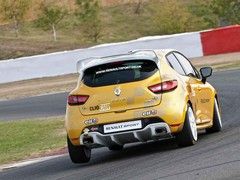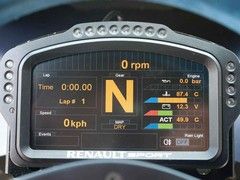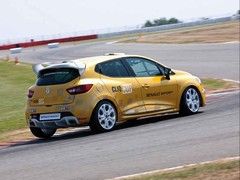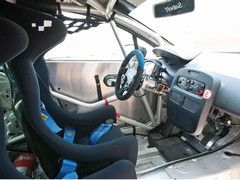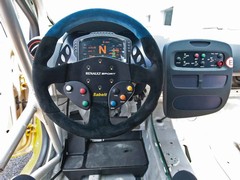Renault Clio Cup Racer: Driven
The roadgoing Clio Cup has matured, so what about the racer? Harris finds out

Appearances flatter to deceive with the new Clio Cup racer. You can throw at this rather big 'little' racer the same criticism hurled at its road-based relative, but doing so rather underlines the lack of emotional baggage in the world of motorsport. No complaints here of paddleshift gearboxes and subjective moaning about turbocharged motors: young guns want all these gizmos because they make for a more comprehensive education.
Back to school
The motor is in a slightly different state of tune to the road car, re-calibrated and sealed by Oreca, giving 220hp and 199lb ft of torque. Kerbweight is up a little at 1,065kg, but overall the car has much more performance than its predecessor: it's over a second quicker around most circuits.
The front-wheel drive racing car is one of the most challenging of the type. I'm a hardened RWD fan, but there's something really challenging about the Clio that immediately makes you want to lap Silverstone's Stowe circuit uninterrupted for most of the day. The spec sheet leads you to believe that the engine and Sadev paddleshift gearbox should dominate the experience, but of course - like any FWD racer - it's all about the diff.
Oh, and the clutch. Pulling away in the Clio Cup makes sauntering around town in an Atom V8 seem serene and easy. The bite point is high, and the relationship between engagement and the torque curve is about as wrong as it could be. There is no dignity in getting moving and I hear there is a modification on the way.
Hopalong
It's a hot day, but even so it takes time to screw any temperature into the rear tyres. For the first few laps the rear axle feels like it's rolling on castors, and then, bang, it feels like a racing car. Immediately far more like a racing car than its predecessor. Gearshifts are fast and greeted with a parpy ignition cut, the steering is electrically light and fast and the car wants to change direction. The 320mm brakes now have no servo, and this brings the other big difference to the driving experience: all the other controls are light, but the middle pedal needs a big, big shove. At first it seems like a poor mismatch, but I loved the extra feel once I was comfortable in the car.
Renault clearly understands what the paying racer likes to see in his or her car. The electronic dash display is pure GT2 racer with loads of functionality and, of course, there are buttons on the steering wheel. We all like buttons.
Talk, steer
For me, the motor is in a different league than before because it has torque to drag you from a turn and a diff that just begs you to bang the power in earlier and earlier. Each turn is an exercise in trail braking right on the edge of a nasty oversteer moment, then the second it takes a set, working the diff to get the best from those Michelin slicks. I suppose my deep affection for the original Focus RS and the Megane R26R can be explained at this point. They're the two road-registered FWD cars that best replicate the delectable feeling you can indulge here, of braking to within an inch of lift-off disaster and then sitting wide-eyed as you unwind the lock, pull another paddle and wonder how just two front wheels can generate so much traction.
This is not a cheap racing car - I'm not aware of many that are. The sticker price is 39,900 euros for the car alone and then you'll need to spend another £12K for your Clio Cup UK entries. That's either a rip-off or a very cheap way of getting yourself shared telly space with our favourite Custard merchant, Mr. Jason Plato. Oh, you'll need to run the car too, which could be anywhere from £70K-£90K, or more if you start destroying shells.
But isn't it strange how technologies which make for a much more competent and engaging racing car - this Clio really does feel like a mini touring car - are gradually being rejected by people who love driving on the road? How long before the marketing departments will be questioning all campaigns boasting of 'developed on the racing track for the road'?
Gassing Station | General Gassing | Top of Page | What's New | My Stuff

